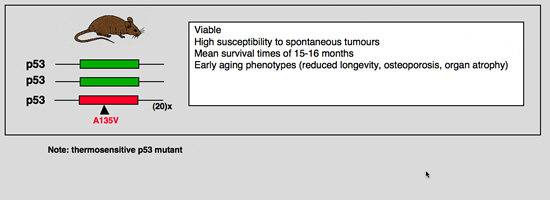| |
p53 Information
p53 information
p53 story
p53 monoclonal antibodies
p53 pathways
p53 gene
mdm family
mouse models
|
mouse p53 A135V
Go back to the list
More recently it has been shown that these mouse could have a premature aging phenoype.
Tyner SD, Venkatachalam S, Choi J, Jones S, Ghebranious N, Igelmann H, Lu X, Soron G, Cooper B, Brayton C, Hee Park S, Thompson T, Karsenty G, Bradley A, Donehower LA (2002) p53 mutant mice that display early ageing-associated phenotypes. Nature 415: 45-53.
 |
Lavigueur, A., V. Maltby, D. Mock, J. Rossant, T. Pawson, and A. Bernstein (1989) Mol Cell Biol 9:3982-3991.
High incidence of lung, bone, and lymphoid tumors in transgenic mice overexpressing mutant alleles of the p53 oncogene.
We have investigated the role of the p53 gene in oncogenesis in vivo by generating transgenic mice carrying murine p53 genomic fragments isolated from a mouse Friend erythroleukemia cell line or BALB/c mouse liver DNA. Elevated levels of p53 mRNA were detected in several tissues of two transgenic lines tested. Increased levels of p53 protein were also detected in most of the tissues analyzed by Western blotting (immunoblotting). Because both transgenes encoded p53 proteins that were antigenically distinct from wild-type p53, it was possible to demonstrate that overexpression of the p53 protein was mostly, if not entirely, due to the expression of the transgenes. Neoplasms developed in 20% of the transgenic mice, with a high incidence of lung adenocarcinomas, osteosarcomas, and lymphomas. Tissues such as ovaries that expressed the transgene at high levels were not at higher risk of malignant transformation than tissues expressing p53 protein at much lower levels. The long latent period and low penetrance suggest that overexpression of p53 alone is not sufficient to induce malignancies and that additional events are required. These observations provide direct evidence that mutant alleles of the p53 oncogene have oncogenic potential in vivo and that different cell types show intrinsic differences in susceptibility to malignant transformation by p53. Since recent data suggest that p53 may be a recessive oncogene, it is possible that the elevated tumor incidence results from functional inactivation of endogenous p53 by overexpression of the mutant transgene. The high incidence of lung and bone tumors suggests that p53 transgenic mice may provide a useful model to investigate the molecular events that underlie these malignancies in humans. |
Go back to the list
|
|






